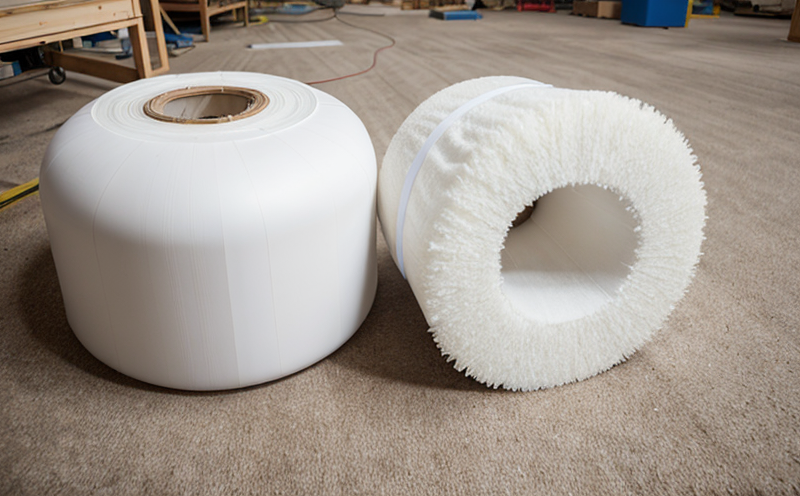ISO 10140-4 Impact Sound Insulation Testing
The ISO 10140-4 standard provides a method for determining the impact sound insulation of partition walls and floors. This service is essential for ensuring that structures meet specified performance criteria, particularly in residential and commercial buildings where noise control is critical. The testing procedure involves measuring the sound pressure levels generated by footsteps or other impacts on one side of a partition and comparing them to those on the opposite side.
The impact sound insulation test evaluates how effectively materials and assemblies reduce sound transmission due to footfalls, drops, or similar actions. This type of testing is crucial for compliance with building codes and standards that aim to minimize noise pollution in residential areas. Compliance with such regulations helps enhance occupant comfort, promote healthier living environments, and reduce the risk of noise-related complaints.
The standard specifies a range of test conditions designed to simulate real-world scenarios. These include different walking speeds, foot types (shoes or barefoot), and various floor coverings. The testing setup typically involves placing an impact sound level meter on the receiving side of the partition with an artificial leg simulating human footfall. This configuration allows for precise measurement of transmitted noise.
The procedure also considers environmental factors that could affect test results, such as temperature, humidity, and air movement. These conditions are carefully controlled to ensure consistent and repeatable measurements. Once the test is conducted under these standardized conditions, the data obtained can be analyzed using specific formulas provided in ISO 10140-4 to calculate the impact sound insulation index (Ra).
Understanding the principles behind this testing method helps stakeholders appreciate its importance. For instance, architects and engineers rely on accurate measurements during design stages to incorporate appropriate materials and solutions that meet regulatory requirements. Similarly, building owners benefit from knowing their structures comply with local regulations before occupancy.
In summary, ISO 10140-4 impact sound insulation testing plays a vital role in ensuring compliance with relevant standards while enhancing overall acoustic performance of buildings. By providing detailed insights into the specific procedures involved, this service supports informed decision-making across various sectors including residential construction, commercial real estate, and public infrastructure projects.
Scope and Methodology
The ISO 10140-4 standard defines a comprehensive approach to assessing impact sound insulation. The test setup includes an artificial leg that simulates human footfall, placed on the transmitting side of the partition being tested. On the receiving side, a microphone is positioned at head height (approximately one meter above floor level) facing the wall or floor under test.
The testing procedure begins by determining the initial conditions within the room where the partition stands. Parameters such as temperature and relative humidity must be recorded before commencing the actual tests. After setting up the equipment according to ISO 10140-4 guidelines, a series of footfalls are generated using specified parameters like walking speed and shoe type.
For each test condition, multiple measurements are taken over several minutes to account for any variability in initial conditions or transient effects. The average value of these readings forms the basis for calculating the impact sound insulation index (Ra). Additionally, the standard recommends performing additional tests under different environmental conditions if necessary.
The results obtained from this testing process provide valuable information about a material's ability to attenuate sound transmitted through partitions. These data points help assess whether the tested materials meet specified performance levels outlined in relevant building codes and standards.
Benefits
Compliance with ISO 10140-4 ensures that buildings achieve optimal acoustic performance, contributing to improved quality of life for occupants. By adhering to these standards during construction, developers can avoid costly rework and potential delays associated with non-compliance issues.
The detailed testing procedures described in ISO 10140-4 enable accurate evaluation of impact sound insulation properties across various materials and assemblies used in partitions. This information allows for informed decisions regarding material selection based on desired acoustic outcomes, thereby enhancing project success rates.
From a regulatory perspective, ensuring compliance with international standards like ISO 10140-4 demonstrates commitment to quality and reliability. It fosters trust among clients and stakeholders, ultimately leading to better business relationships.
Additionally, the standardized testing methods employed in this service facilitate consistent evaluation across different projects and locations worldwide. This consistency is particularly beneficial for multinational organizations operating globally, as it ensures uniformity in acoustic performance assessments regardless of geographical differences.
In conclusion, ISO 10140-4 impact sound insulation testing offers numerous advantages that contribute to successful project outcomes and satisfied clients.
Competitive Advantage and Market Impact
The ability to offer high-quality ISO 10140-4 impact sound insulation testing services sets laboratories apart in the market. This unique capability allows them to provide accurate, reliable data that enables architects, engineers, and builders to make informed decisions about material selection and design.
By leveraging advanced instrumentation and experienced personnel trained specifically in this field, these labs can consistently deliver precise test results. Such expertise ensures not only compliance with international standards but also exceeds expectations set by clients seeking cutting-edge solutions.
The demand for sustainable building practices continues to grow globally, driven by environmental concerns and increased awareness of the importance of energy efficiency. Laboratories offering ISO 10140-4 testing play a crucial role in supporting these trends by providing essential data that informs the development of eco-friendly materials and construction techniques.
Moreover, as regulations become more stringent regarding noise reduction in urban environments, there is an increasing need for reliable testing services like those provided under ISO 10140-4. These laboratories cater to this growing demand by delivering consistent, accurate results that help clients stay ahead of regulatory changes.
In summary, the competitive advantage gained through providing ISO 10140-4 impact sound insulation testing extends beyond mere compliance; it also enhances reputation and positions organizations as leaders in their respective fields.





